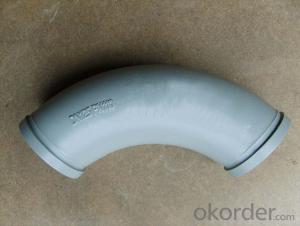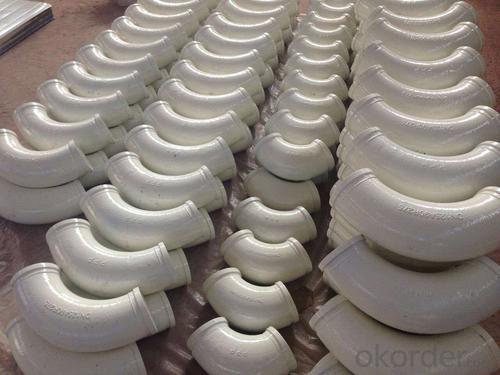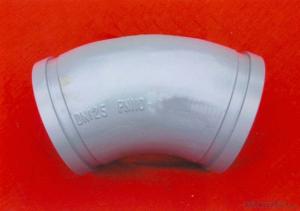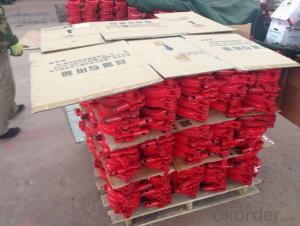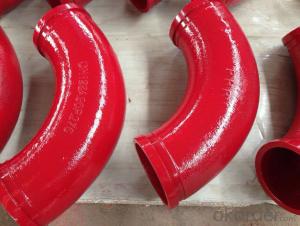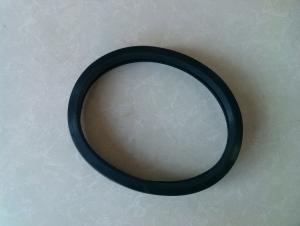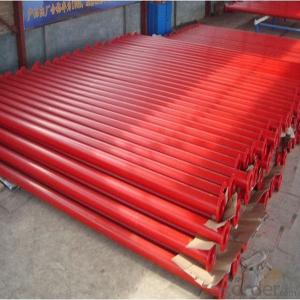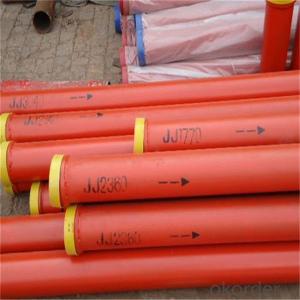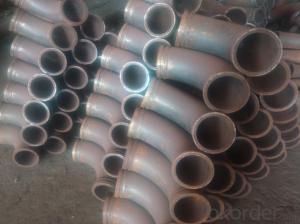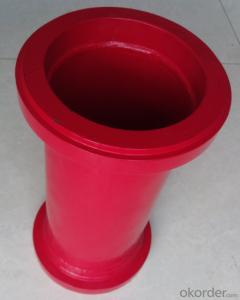CONCRETE DELIVERY ELBOW SCHWING TYPE 90DEG R275 DN125
- Loading Port:
- Tianjin
- Payment Terms:
- TT OR LC
- Min Order Qty:
- 100 pc
- Supply Capability:
- 10000 pc/month
OKorder Service Pledge
OKorder Financial Service
You Might Also Like
concrete pump elbow table
Wear-resistant Single or Double Concrete Pump Elbow | |||||||
Type | Singe Elbow | Double Elbow | |||||
Model | DN125 | DN150 | DN175 | DN125 | |||
Material | Casting Steel ,ST52 | Inside | 40Cr | Outside | |||
Size | R275*90° | R275*90°+110 | 36° | F2000 | R275*90° | R275*90°+110 | |
R275*45° | R275*90°+211 | R400*30° | A3000 | R275*45° | R275*90°+211 | ||
R275*25° | R275*90°+411 | R400*45° | 471B | R275*25° | R275*90°+411 | ||
R275*20° | R275*90°+424 | R400*30° | 571B | R275*20° | R275*90°+424 | ||
R275*15° | R275*45°+170 | R488*90° | A1000 | R275*15° | R275*45°+170 | ||
R180*90° | R275*45°+310 | R500*90 | C1000 | R180*90° | R275*45°+310 | ||
R232*60° | R275*45°+310 | R280*90° | B2000 | R232*60° | R275*45°+310 | ||
R240*36° | 20°Lengthen | R240*36° | 20°Lengthen | ||||
R240*30° | 25°+740 | R240*30° | 25°+740 | ||||
R240*15° | 40°Zoomlion | R240*15° | 40°Zoomlion | ||||
R385*29° | R385*29° | ||||||
R315*33° | R315*33° | ||||||
Technic | Forged | ||||||
Average life | 25,000cubic | 50,000cubic | |||||
Appliciation | Used in concrete transport in construction work | ||||||
1.product profile:The double layer concrete pump elbow is developed by ourselves through new
technology and process.
2.characteristic:the inner layer of this concrete pump elbow undergoes heat treatment,and then the rigitiry can reach 62-65HRC.
3.characteristic:the outer layer of the concrete pump elbow possess good toughness properties
to protect the inner layer,so the security of the elbow is improved.
4.life:the experiment done abroad shows that the life of our concrete pump elbow can reach 35000-50000cbm,got the customers' praise
5.Beside the double layer concrete pump elbow,we produce all kinds of concrete pump parts,
straight pipe hose flange coupling and so on.
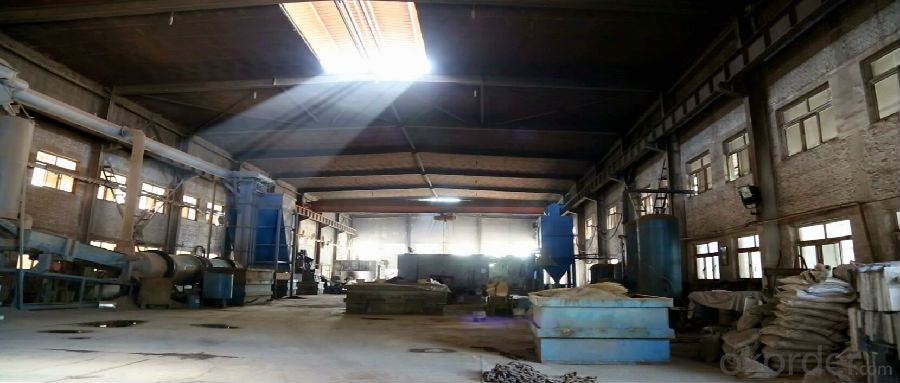
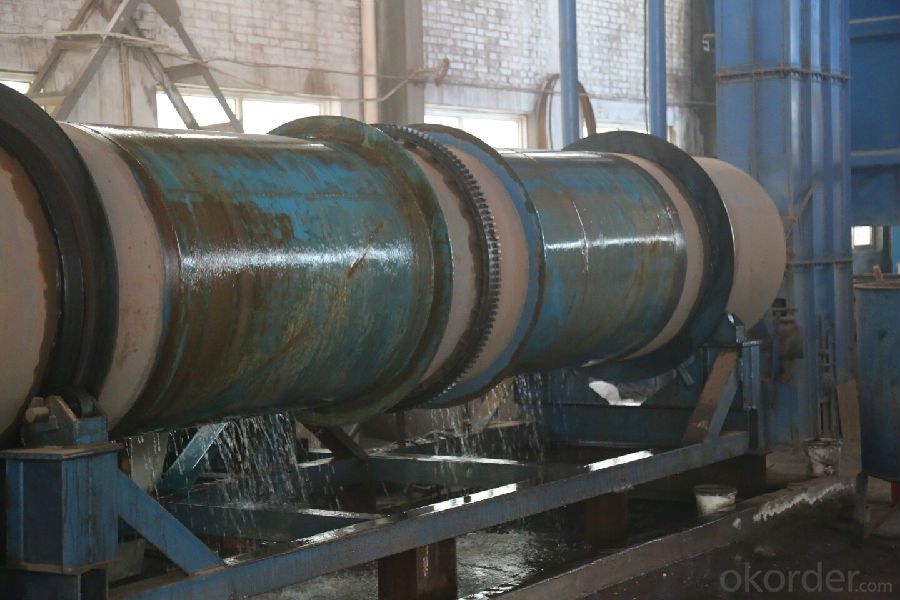
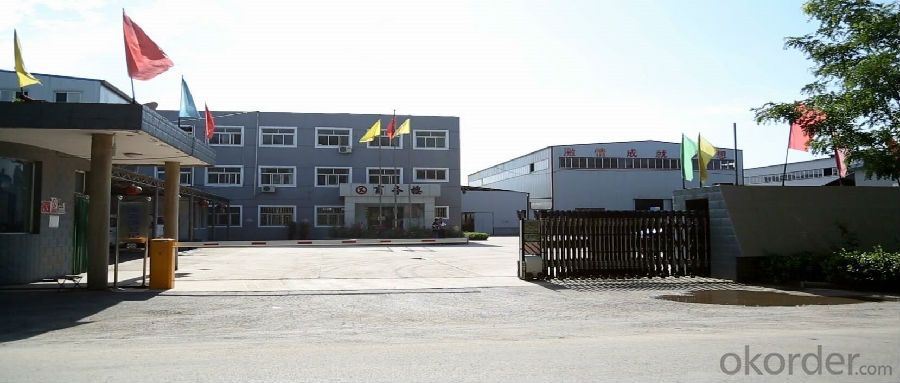
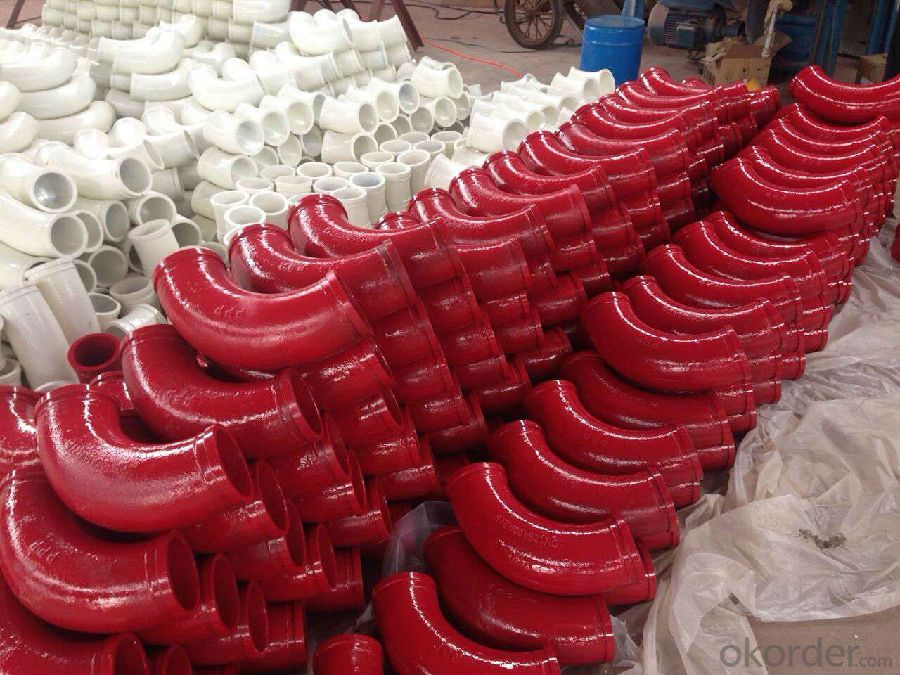
- Q: Can concrete pump spare parts be coated with UV-resistant coatings for outdoor applications?
- Yes, concrete pump spare parts can be coated with UV-resistant coatings for outdoor applications. These coatings provide protection against the harmful effects of ultraviolet rays, preventing damage and extending the lifespan of the parts when exposed to sunlight.
- Q: How can a damaged concrete pump hopper affect the pumping process?
- A damaged concrete pump hopper can have several negative impacts on the pumping process. Firstly, a damaged hopper can lead to a decrease in efficiency and productivity. The hopper is responsible for holding and feeding the concrete mixture into the pump, and any damage to it can result in a disruption of the continuous flow of concrete. This can lead to frequent interruptions in the pumping process, causing delays and reducing the overall output of the pump. Secondly, a damaged hopper can affect the quality of the concrete being pumped. The hopper is designed to ensure proper mixing and consistency of the concrete mixture before it is pumped. If the hopper is damaged, it may not be able to effectively mix the concrete, leading to inconsistencies in the mixture. This can result in poor-quality concrete being pumped, which can compromise the structural integrity and durability of the final product. Moreover, a damaged hopper can pose safety risks for the workers involved in the pumping process. A damaged hopper may have sharp edges or loose parts that can cause injury if not properly addressed. Additionally, if the hopper is not functioning properly, it may lead to clogs or blockages in the pump, which can cause pressure build-up and potential accidents. Lastly, a damaged hopper can increase maintenance and repair costs. A hopper that is not in optimal condition may require frequent repairs or even replacement, which can be costly in terms of time and money. Regular maintenance and inspection of the hopper is crucial to identify any damages early on and prevent them from escalating into more significant issues. In conclusion, a damaged concrete pump hopper can significantly affect the pumping process by reducing efficiency, compromising the quality of the concrete, posing safety risks, and increasing maintenance costs. Regular inspection, maintenance, and timely repairs are essential to ensure the smooth operation of the pump and the delivery of high-quality concrete.
- Q: How can one determine the correct viscosity and temperature range for lubricants used in concrete pump spare parts?
- Determining the appropriate viscosity and temperature range for lubricants used in concrete pump spare parts requires the consideration of multiple factors. Below are some steps that can assist in determining the suitable viscosity and temperature range: 1. Refer to the manufacturer's recommendations: To begin with, consult the specific guidelines or recommendations provided by the manufacturer for the concrete pump spare parts. The manufacturer may specify the required viscosity and temperature range for the lubricants used in their equipment. 2. Gain a clear understanding of the operating conditions: It is essential to have a comprehensive understanding of the operating conditions in which the concrete pump spare parts will be utilized. Factors such as ambient temperature, pump speed, load, and pressure should be taken into account. These factors can significantly impact the viscosity requirements and temperature range of the lubricant. 3. Assess the performance characteristics of the lubricant: Different lubricants possess distinct performance characteristics that make them suitable for particular applications. Look for lubricants specifically formulated for heavy-duty tasks, offering excellent wear protection and displaying good thermal stability. These performance characteristics ensure that the lubricant can endure the demanding conditions of a concrete pump. 4. Viscosity requirements: The viscosity of the lubricant plays a crucial role in ensuring proper lubrication and safeguarding of the concrete pump spare parts. Heavy-duty applications generally require higher viscosity lubricants, while lighter loads may be better suited with lower viscosity lubricants. The viscosity requirements may also differ depending on the specific pump parts, such as bearings, gears, or seals. Referring to the manufacturer's guidelines and seeking advice from lubricant suppliers can help determine the ideal viscosity range for the concrete pump spare parts. 5. Consider the temperature range: The temperature range within which the concrete pump operates is another significant aspect to consider. Lubricants should be capable of maintaining their viscosity and performance across the expected temperature range. Extreme temperatures can cause lubricants to lose their effectiveness, potentially leading to equipment damage or failure. Consequently, it is important to select lubricants with a temperature range suitable for the operating conditions of the concrete pump. 6. Consult with experts: If uncertainty persists regarding the appropriate viscosity and temperature range, it is advisable to seek advice from lubricant manufacturers, suppliers, or industry experts. They can offer valuable insights and recommendations based on their expertise and experience with concrete pump spare parts. By adhering to the manufacturer's recommendations, comprehending the operating conditions, evaluating the lubricant's performance characteristics, and seeking professional advice, it becomes possible to determine the correct viscosity and temperature range for lubricants used in concrete pump spare parts. This will ensure optimal lubrication and extend the lifespan of the equipment.
- Q: What are the fittings of concrete pump?
- Fine stone concrete pump parts are: main oil cylinder, concrete cylinder, three-phase asynchronous motor, main oil pump, hopper, S pipe, electric distribution cabinet, hand oil pump, piston
- Q: What is the purpose of a concrete pump wear plate?
- To safeguard the pumping system against the abrasive characteristics of concrete, a concrete pump wear plate is employed. In the course of transferring concrete from the mixer to the construction site, the wear plate acts as a shield, preventing direct contact between the pumping system and the abrasive concrete. Consequently, the detrimental effects caused by the constant flow of concrete are minimized. The wear plate is typically constructed from durable materials such as hardened steel or tungsten carbide, which possess resistance against the abrasive forces exerted by the concrete. By implementing a wear plate, the lifespan of the pumping system is significantly prolonged, thereby reducing the frequency of repairs and replacements. Ultimately, the objective of a concrete pump wear plate is to ensure the efficient and dependable operation of concrete pumps by safeguarding and preserving the integrity of the pumping system.
- Q: What is the role of a concrete pump hopper grate spring?
- The role of a concrete pump hopper grate spring is to provide tension and support to the hopper grate, ensuring that it remains securely in place while allowing for smooth and consistent flow of concrete through the pump.
- Q: What is the purpose of a concrete pump cleaning ball?
- The purpose of a concrete pump cleaning ball is to clean out residual concrete and debris from the pumping system, ensuring proper functioning and preventing blockages or clogs.
- Q: How do I troubleshoot common problems with concrete pump spare parts?
- Troubleshooting common problems with concrete pump spare parts can be done through a systematic approach. Here are some steps to help you identify and resolve issues: 1. Identify the problem: Start by observing the symptoms and identifying the specific issue you are facing. This can include leaks, reduced pumping efficiency, abnormal noise, or power failure. 2. Check for clogs or blockages: Inspect the pump's hoses, pipes, and valves for any clogs or blockages that may be hindering the flow of concrete. Clear out any debris or obstructions that you find. 3. Inspect the wear parts: Examine the wear parts such as the pump's pistons, seals, or gaskets. Look for signs of wear and tear, cracks, or damage. If necessary, replace any worn-out parts. 4. Check for air leaks: Air leaks can affect the pump's performance and efficiency. Inspect the fittings, connections, and seals for any signs of air leakage. Tighten loose fittings or replace faulty seals as needed. 5. Ensure proper lubrication: Lack of lubrication can cause friction and damage to the pump's moving parts. Check the lubrication system and ensure that it is functioning properly. Add lubricant if necessary. 6. Verify electrical connections: If you are experiencing power failure or electrical issues, check the electrical connections of the pump. Look for loose or damaged wires and connections. Repair or replace any faulty components. 7. Consult the manufacturer's manual: The manufacturer's manual can provide valuable troubleshooting information specific to your concrete pump spare parts. Refer to the manual to understand the recommended maintenance procedures and troubleshooting steps. 8. Seek professional assistance if needed: If you are unable to identify or resolve the issue on your own, it is advisable to seek professional assistance. Contact a qualified technician or the manufacturer's customer support for further guidance and support. Remember, regular maintenance and proper usage of concrete pump spare parts can minimize the occurrence of problems.
- Q: How often should hydraulic cylinders be inspected or replaced in a concrete pump?
- It is advisable to conduct regular inspections on hydraulic cylinders in a concrete pump, ideally every 500 hours of operation or at least once a year, whichever occurs first. However, it is important to acknowledge that the frequency of inspections may differ based on the specific conditions and usage of the concrete pump. During these inspections, qualified technicians should thoroughly assess the hydraulic cylinders for any indications of wear, damage, or leaks. Additionally, they should verify the alignment, piston rods, seals, and other components to ensure proper functionality. If any issues are discovered, such as excessive wear or leaks, it is recommended to promptly replace the hydraulic cylinders to prevent further damage and maintain optimal performance. The regular inspections and timely replacements of hydraulic cylinders are vital for guaranteeing the safety, efficiency, and longevity of a concrete pump. Neglecting proper maintenance can result in expensive repairs, decreased productivity, and even accidents. Therefore, it is crucial to adhere to the manufacturer's guidelines and seek advice from professionals to determine the appropriate intervals for inspecting and replacing hydraulic cylinders in a concrete pump.
- Q: Do concrete pump spare parts come with a warranty?
- Yes, concrete pump spare parts do come with a warranty. The warranty period may vary depending on the manufacturer and the specific part being purchased. Generally, reputable manufacturers and suppliers offer warranties on their spare parts to provide assurance to customers about the quality and reliability of the product. It is important to carefully review the terms and conditions of the warranty to understand what is covered and for how long. If any defects or issues arise during the warranty period, customers can typically get a replacement or have the part repaired at no additional cost.
Send your message to us
CONCRETE DELIVERY ELBOW SCHWING TYPE 90DEG R275 DN125
- Loading Port:
- Tianjin
- Payment Terms:
- TT OR LC
- Min Order Qty:
- 100 pc
- Supply Capability:
- 10000 pc/month
OKorder Service Pledge
OKorder Financial Service
Similar products
Hot products
Hot Searches
Related keywords
